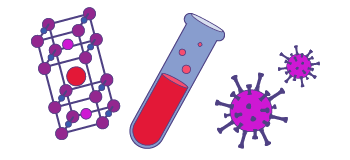The contactless Surface Acoustic Wave (SAW) technique is implemented to probe the high-frequency conductivity in low dimensional (2D) structures, by measuring the SAW attenuation and velocity.
A SAW is excited on a side of a piezoelectric platelet (LiNbO3) by an inter-digital transducer. The SAW propagating along the plane of lithium niobate is accompanied by a high-frequency electric field. This electric field penetrates into the 2D channel located in the semiconductor structure placed on the surface. The field produces electrical currents, which, in turn, cause Joule losses. As a result of the interaction of the SAW electric field with charge carriers, the SAW attenuation and its velocity shift are governed by the complex high-frequency conductivity, σhf(ω) . Therefore, the real and imaginary parts of the conductivity could be calculated from the SAW attenuation and velocity measured in the experiment. This “sandwich"-like experimental configuration enables contactless acoustoelectric experiments on non-piezoelectric 2D systems, for example built from Si and Ge.
Resistive Magnets
Superconducting Magnets

Explore our magnet schedule to see what exciting research is happening on our stellar fleet of instruments right now.
I.L. Drichko et al., Electronic band structure in n-type GaAs/AlGaAs wide quantum wells in tilted magnetic field, Journal of Physics-Condensed Matter, 32, 3, 035303 (2020) Read online.
I.L. Drichko et al., Composite fermions in a wide quantum well in the vicinity of the filling factor 1/2, Solid State Communications, 301, 113698 (2019) Read online.
I.L. Drichko et al., Intersubband scattering in n-GaAs/AlGaAs wide quantum wells, Physical Review B, 97, 075427 (2018) Read online.
I.L. Drichko et al., Melting of Wigner crystal in high-mobility n-GaAs/AlGaAs heterostructures at filling factors 0.18>n>0.125: Acoustic studies, Physical Review B, 94, 7, 075420 (2016) Read online.
Last modified on 13 December 2023